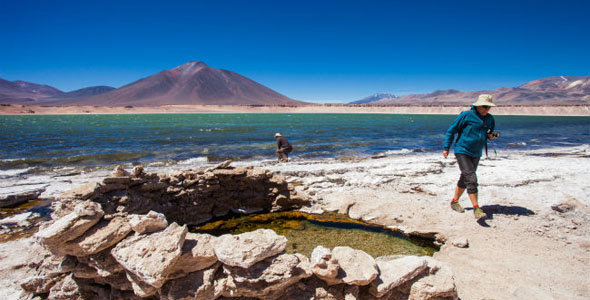There are some of the attractions you can visit around Dakar route.
We can already feel the Dakar Rally arriving, and the Atacama Desert will be hosting this great event by receiving the whole caravan between the 7th and 14th of January. It is quite a location, where the combination of desert and sea result in landscapes you will not want to miss out on.
It has become a tradition during January. The most extreme rally in the world and Chile is once again the main character. The cities of Copiapó, Antofagasta, Iquique and Calama are preparing themselves for this racing sport event, offering several tourism destinations to visit. Below find some of the attractions you can visit around these cities.
Laguna Santa Rosa-Laguna Verde: Both are close to Copiapo and both are a spectacle of nature. The Santa Rosa Lagoon is the southeastern gateway to the Maricunga Salt Flat. On its shores you find a large formation of wetlands and other flora typically found in high altitudes. Other possible sightings are herds of guanacos, as well as different bird species such as parinas and piuquenes (Andean geese). Verde Lagoon, apparently lifeless, is of a gorgeous emerald green and its plains surrounded by snow-covered volcanoes, the Ojos del Salado, Mulas Muertas, and Incahuasi. This sector does not present much fauna, but the beautiful scenic views have no comparison.
Atacama Salt Flat: Many travelers come here searching for flamingos and other bird species that nest and feed in their “water eyes” or natural ponds, like the Chaxa lagoon. The three species you can see up close are the Andean, Chilean and James flamingos, and its differences can be spotted out by the local guides that protect the area.
North of the salt flat is the Tulor village, an archeological site formed by interconnected circular constructions that date back between 800 B.C. and 500 A.C. It was buried underground for centuries, and part of it has been uncovered through scientific excavations to be seen and appreciated. Within the Atacama Salt Flat you encounter the Cejar Lagoon, resembling the Dead Sea, so be sure to take a swim, or better said, a float!
Colchane: Situated in the altiplano of the Iquique Province, 262 km northeast of the city of Iquique and 2,013 north of Santiago. The tourism resources that this district possesses give those adventure seeking visitors a great deal to do. The inhabitants come from ethnic groups that do not have a precise place of origin; however, some investigators assure the Aymaras come from the northeastern Amazon, attracted by the splendor of the Tiahuanacu culture that was centered on the Titicaca Lake. The different cultural influences and pre-Hispanic ethnical mixtures put together a group in the altiplano that structured themselves as people devoted to the land.
The Huanchaca Ruins: A modern building-museum with esplanades was generated under the wing of the Fundación Ruinas de Huanchaca (the Huanchaca Ruins Foundation). The complex stopped being used over 100 years ago, where today, aside from the ruins, a diversity of pieces reflecting the industrial activity of the era is exposed.
